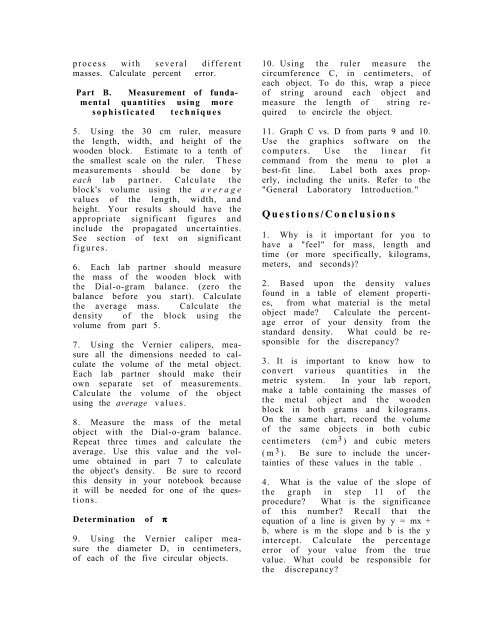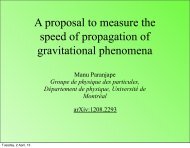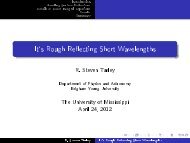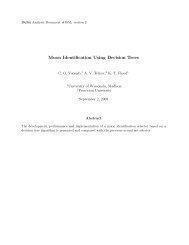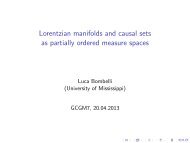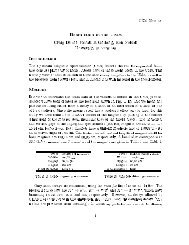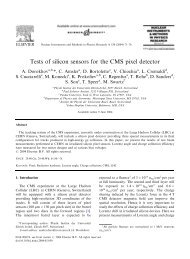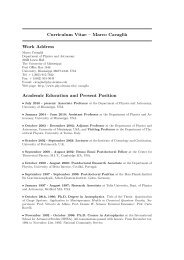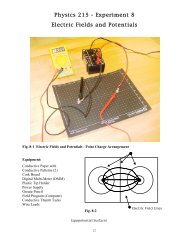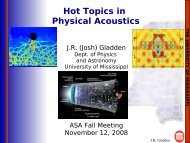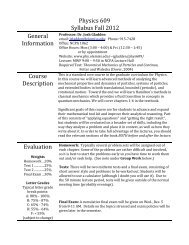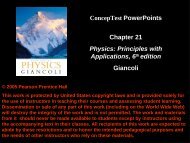Experiment 1 Measurement
Experiment 1 Measurement
Experiment 1 Measurement
You also want an ePaper? Increase the reach of your titles
YUMPU automatically turns print PDFs into web optimized ePapers that Google loves.
process with several different<br />
masses. Calculate percent error.<br />
Part B. <strong>Measurement</strong> of fundamental<br />
quantities using more<br />
sophisticated techniques<br />
5. Using the 30 cm ruler, measure<br />
the length, width, and height of the<br />
wooden block. Estimate to a tenth of<br />
the smallest scale on the ruler. These<br />
measurements should be done by<br />
each lab partner. Calculate the<br />
block's volume using the average<br />
values of the length, width, and<br />
height. Your results should have the<br />
appropriate significant figures and<br />
include the propagated uncertainties.<br />
See section of text on significant<br />
figures.<br />
6. Each lab partner should measure<br />
the mass of the wooden block with<br />
the Dial-o-gram balance. (zero the<br />
balance before you start). Calculate<br />
the average mass. Calculate the<br />
density of the block using the<br />
volume from part 5.<br />
7. Using the Vernier calipers, measure<br />
all the dimensions needed to calculate<br />
the volume of the metal object.<br />
Each lab partner should make their<br />
own separate set of measurements.<br />
Calculate the volume of the object<br />
using the average values.<br />
8. Measure the mass of the metal<br />
object with the Dial-o-gram balance.<br />
Repeat three times and calculate the<br />
average. Use this value and the volume<br />
obtained in part 7 to calculate<br />
the object's density. Be sure to record<br />
this density in your notebook because<br />
it will be needed for one of the questions.<br />
Determination of π<br />
9. Using the Vernier caliper measure<br />
the diameter D, in centimeters,<br />
of each of the five circular objects.<br />
10. Using the ruler measure the<br />
circumference C, in centimeters, of<br />
each object. To do this, wrap a piece<br />
of string around each object and<br />
measure the length of string required<br />
to encircle the object.<br />
11. Graph C vs. D from parts 9 and 10.<br />
Use the graphics software on the<br />
computers. Use the linear fit<br />
command from the menu to plot a<br />
best-fit line. Label both axes properly,<br />
including the units. Refer to the<br />
"General Laboratory Introduction."<br />
Questions/Conclusions<br />
1. Why is it important for you to<br />
have a "feel" for mass, length and<br />
time (or more specifically, kilograms,<br />
meters, and seconds)?<br />
2. Based upon the density values<br />
found in a table of element properties,<br />
from what material is the metal<br />
object made? Calculate the percentage<br />
error of your density from the<br />
standard density. What could be responsible<br />
for the discrepancy?<br />
3. It is important to know how to<br />
convert various quantities in the<br />
metric system. In your lab report,<br />
make a table containing the masses of<br />
the metal object and the wooden<br />
block in both grams and kilograms.<br />
On the same chart, record the volume<br />
of the same objects in both cubic<br />
centimeters (cm 3 ) and cubic meters<br />
(m 3 ). Be sure to include the uncertainties<br />
of these values in the table .<br />
4. What is the value of the slope of<br />
the graph in step 11 of the<br />
procedure? What is the significance<br />
of this number? Recall that the<br />
equation of a line is given by y = mx +<br />
b, where is m the slope and b is the y<br />
intercept. Calculate the percentage<br />
error of your value from the true<br />
value. What could be responsible for<br />
the discrepancy?


